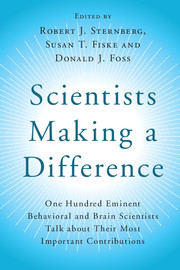 Scientists Making a Difference
Scientists Making a Difference from Section A - Motivation
Published online by Cambridge University Press: 05 August 2016
Over the course of my fifty-year career, I have written three books and a number of well-cited papers and chapters. Each of these books, and several of the papers and chapters, had their genesis in a written exchange with a friend while I was still in graduate school. We both had done work on the misattribution of one's own emotional state, but the provocative paper he sent in draft form broke new ground. In my otherwise positive two-page response, I raised two issues. The friend was Richard Nisbett, who had been my senior classmate at Columbia and who by then was an assistant professor at Yale. The 1971 paper co-authored by Ned Jones soon became a classic in the attribution theory literature. It was titled “Actors and Observers: Divergent Perceptions of the Causes of Behavior.”
Jones and Nisbett offered a compelling mix of empirical observations, anecdotal examples, laboratory findings, and plausible mechanisms in support of the claim that actors are inclined to attribute their own actions, preferences, and choices to features of the relevant situation, but attribute the responses of other actors to the “dispositions” of those actors. My comments included two questions.
Two Questions Posed to My Colleague
Is there a more fundamental main effect than the actor–observer difference? One issue I raised was the possibility that the phenomenon Jones and Nisbett had identified reflected a difference in the degree to which actors and observers, albeit to different degrees, were succumbing to a more “fundamental” bias. This issue was pursued in my 1977 chapter in the Advances in Social Psychology series titled “The Intuitive Psychologist and His Shortcomings” and explored at length in each of the three books I subsequently co-authored. My own contribution consisted mainly in naming this “fundamental attribution error” and in pointing out the role it played in the seeming non-obviousness of so many classic research findings, whereby particular situational pressures and constraints led research participants to act in ways that challenge our notions about how “ordinary” people behave. But that is not the story I shall tell in the remainder of this chapter. (If that story interests you, Human Inference and later The Person and the Situation, both co-authored with Richard Nisbett, are the places to find it.)
To save this book to your Kindle, first ensure no-reply@cambridge.org is added to your Approved Personal Document E-mail List under your Personal Document Settings on the Manage Your Content and Devices page of your Amazon account. Then enter the ‘name’ part of your Kindle email address below. Find out more about saving to your Kindle.
Note you can select to save to either the @free.kindle.com or @kindle.com variations. ‘@free.kindle.com’ emails are free but can only be saved to your device when it is connected to wi-fi. ‘@kindle.com’ emails can be delivered even when you are not connected to wi-fi, but note that service fees apply.
Find out more about the Kindle Personal Document Service.
To save content items to your account, please confirm that you agree to abide by our usage policies. If this is the first time you use this feature, you will be asked to authorise Cambridge Core to connect with your account. Find out more about saving content to Dropbox.
To save content items to your account, please confirm that you agree to abide by our usage policies. If this is the first time you use this feature, you will be asked to authorise Cambridge Core to connect with your account. Find out more about saving content to Google Drive.